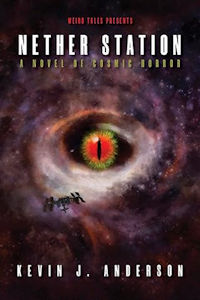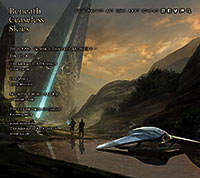Nether Station by Kevin J. Anderson: Review by Paul Di Filippo
 Nether Station, Kevin J. Anderson (Blackstone 979-8200688449, hardcover, 316pp, $27.99) October 2024
Nether Station, Kevin J. Anderson (Blackstone 979-8200688449, hardcover, 316pp, $27.99) October 2024
The crew of a small survey spaceship voyages out to investigate a spacetime anomaly, and encounters deadly supernatural (?) entities. Am I about to take a second pass at reviewing Adam Roberts’s recent Lake of Darkness? Not at all! But by phrasing the plot of that novel generically, I can point out that although certain adjacent works might utilize the same stefnal “power chord,” they can still turn out vastly different, yet equally accomplished. That’s the case when we hold up Anderson’s newest to the Roberts volume. Despite a surface similarity, we end up with different vibes, effects and narrative strategies.
Surely most readers will have encountered Anderson’s work in one guise or another. The list of his prior publications occupies two entire pages in the front of this book. But I’ll bet that most folks know him through his various franchises (anyone ever heard of Dune?) and his self-developed series, whereas his standalone novels—of which this is one—offer quirkier pleasures. For instance, I am intensely fond of his comic book work in JSA: Strange Adventures, which managed to feature Jack Williamson as the protagonist.
This tale takes place at an unspecified, semi-near-future date—let’s posit maybe thirty or forty years from now. An unmanned government space probe, while exploring the Kuiper Belt, discovers an object which the physics boffins determine is a wormhole. The probe accidently falls into the wormhole, and that seems the end of mankind’s ability to learn more for now, since it takes five years to reach the Kuiper zone.
But then, four years later, the missing probe’s signals arrive at Earth. It is quickly deduced that the signals emanate from Alpha Centauri. The probe transited the wormhole safely and emerged four lightyears away. Naturally, this stirs greater interest. The first mission to follow up is funded by private enterprise. Benedict Noor is an egocentric playboy-adventurer gazillionaire, plainly modeled on Elon Musk and his ilk. (This manically alluring character type has cropped up recently in quite a handful of SF novels, and we must thank Musk for his contributions to literary history. Although of course, as with so much else, Heinlein had earlier established such a fellow with D. D. Harriman. Yet unlike Musk, Harriman embodied the virtues, without so many vices, of that earlier age.)
Noor has selected about a score of scientists to make the voyage—and insists on going himself, ostensibly as captain, although another more competent gal is the real pilot. They will all pass the five years in cryopods, coming awake in short rotating shifts.
Our main viewpoint character—although everyone cycles through as a POV set of eyes—is one Cammie Skoura. A young astrophysics genius, she lies on the neurodivergent spectrum, and is maladroit with her peers. Her simple nature invites the reader into the tale.
The novel quickly cuts to the ship’s arrival next to the wormhole. About six of the crew, including Cammie and Noor, are already awake on this momentous arrival shift. But when they go to release the others from their cryopods, the first trouble occurs: deadly malfunctions.
Saddened but undaunted, they decide to continue the mission; not much choice when you’re five years’ travel away from home and have billions invested.
Now, up to this point, we might have been reading a book by Stephen Baxter. Everything is depicted with extreme logic, plausibility, and hard-SF verisimilitude. Then, on page 110, Noor says, “Maybe I’ll name this crater after Archibald Benton and his Miskatonic Expedition.”
Whoa! I waited for this remark to be revealed as a fannish jape, as if Noor were a big HPL fan. But no. This timeline, seemingly so rational and like ours, proves to be identical with the Mythos continuum.
This shock is what I get for disregarding an emblem on the front cover which stated the book was part of a series dubbed “Weird Tales Presents”!
I think you can see where our tale goes from here, and I shan’t spoil Anderson’s inventive Cthulhuian surprises, shocks and horrors. Just let me say that he comes pretty close to matching the Master for eldritch doings. Here’s a sample encounter that should not be too big a reveal.
On the crater floor where they stood, the high cliff wall made the shadows deeper. The enormous ice columns towered against the cliff like frozen redwoods, where they supported an immense overhang with a façade designed to evoke majesty and fear. The frozen stairs that ascended to the throne platform were grimy with eons of cosmic dust and pitted with tiny impacts. Each riser was almost two meters high, built for massive beings.
The language of course is not as lush as HPL’s, but Anderson’s clear-eyed sober prose does good duty in all the various scenes.
Our subsidiary characters all emerge nicely invested with psychological solidity. And they meet very surprising fates. Our two main figures, Cammie and Noor, trace small arcs of inner development that feel satisfying. Nor is the ending of the book blackly nihilistic. Anderson the SF guy could just not resist a note of hopefulness.
This kind of hybrid SF-Horror is a potent one, since each mode serves as an illuminating foil to the other. “You got technology in my ghost story!” “You got a ghost in my technology!” “Two great tastes that taste great together!” Anderson maintains a fine balance between the two magisteria (in the Stephen Jay Gould sense of that term) and the reader will experience cosmic horror at its finest.
Interested in this title? Your purchase through the links below brings us a small amount of affiliate income and helps us keep doing all the reviews you love to read!
 While you are here, please take a moment to support Locus with a one-time or recurring donation. We rely on reader donations to keep the magazine and site going, and would like to keep the site paywall free, but WE NEED YOUR FINANCIAL SUPPORT to continue quality coverage of the science fiction and fantasy field.
While you are here, please take a moment to support Locus with a one-time or recurring donation. We rely on reader donations to keep the magazine and site going, and would like to keep the site paywall free, but WE NEED YOUR FINANCIAL SUPPORT to continue quality coverage of the science fiction and fantasy field.
©Locus Magazine. Copyrighted material may not be republished without permission of LSFF.









